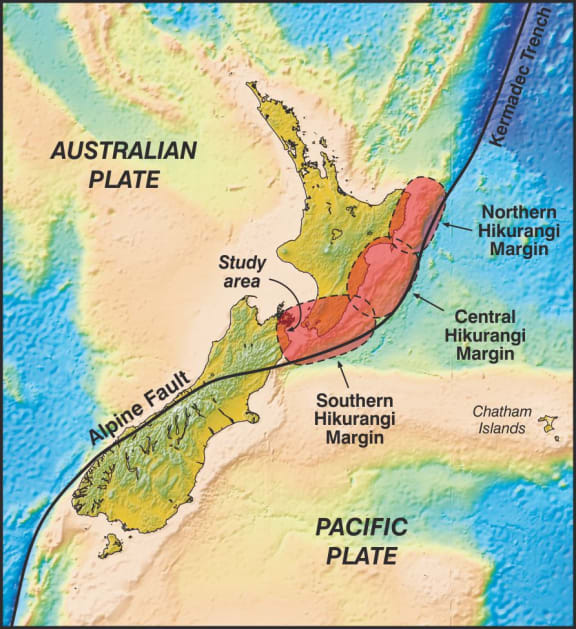by Veronika Meduna
Subduction earthquakes have the potential to be very big because subduction zones are very big features.
GNS Science earthquake geologist Kate Clark

Geologists now have evidence for subduction earthquakes that happened on the southern part of the Hikurangi Margin, in the Cook Strait-Marlborough region. Photo: GNS Science
For the first time, geologists have found direct evidence for large “megathrust” subduction earthquakes beneath central New Zealand, along the southern part of the Hikurangi margin, which marks the collision zone between the Pacific and Australian tectonic plates.
The team identified the geological signatures of two subduction earthquakes that have ruptured in the past 1000 years, and this is the first direct evidence that the plate boundary under the Cook Strait-Marlborough area can produce large earthquakes.
Lead author and GNS Science earthquake geologist Kate Clark says subduction earthquakes differ from other quakes in that they occur at the interface between two plates, rather than along faultlines within the upper plate.
They are responsible for some of the biggest quakes – and tsunamis – in the world, including the recent magnitude 9.0 Tohoku earthquake and tsunami in Japan in March 2011 and the magnitude 9.3 Indian Ocean earthquake and tsunami in December 2004.
“Subduction earthquakes have the potential to be very big because subduction zones are very big features,” says Kate Clark. “And being able to generate a larger earthquake means that ground shaking will go on for a longer time.”
Kate Clark says geologists already had some evidence for such earthquakes on the northern section of the Hikurangi margin so the risk is not new for New Zealand, but this study provides greater certainty.
I feel like our research is just the start of what we can understand about these earthquakes. Now we know that they do occur, and we have found evidence of what they do at one location. What we will now do is try to look for other locations around the lower North Island and upper South Island of these same earthquakes, and if we can find out … how much uplift and subsidence there was or how large the tsunami was, then we can combine all that information and hopefully one day start to understand the magnitude of the earthquake.”

The team analysed sediment cores extracted from Big Lagoon, a coastal lake in the Wairau Valley, near Blenheim. Photo: GNS Science
The team identified the quakes from sediment cores extracted from Big Lagoon, a large coastal lake east of Blenheim. Radiocarbon dates of organic material from different levels of the cores show evidence of two sudden subsidence events, first at 880 to 800 years ago and again at 520 to 470 years ago, when the land dropped by up to half a metre.
Sudden drops like this can only be explained by moderate-to-large earthquakes, and these two events do not match any known significant earthquakes on nearby faults in the upper Australian plate.
“The findings are significant in terms of understanding earthquake and tsunami hazards in the lower North Island and upper South Island,” says Kate Clark.
Judging by the sedimentary debris found at the time of the first earthquake, this event was accompanied by tsunami that was more than three metres high and swept more than 360 meters inland.
If a similar event were to happen today, she says the damage would be significant.
“An earlier study, which modelled a magnitude 8.9 earthquake - that is our worst-case scenario - estimates in the Wellington region alone about $13 billion of damage and several thousand fatalities.
“I should point out that most of the fatalities are probably from the tsunami and not from the earthquake shaking, so if we can get the message across to the people to heed tsunami warnings and self-evacuate when they feel a strong earthquake, then these fatalities can be reduced.”
From the evidence available, the team couldn’t estimate the size of the two quakes, but Kate Clark says quakes with similar impacts in comparable geological settings are larger than magnitude 7.5.
“We would like to go further back in time and find evidence of older subduction earthquakes,” she says. “With a longer record of past subduction earthquakes we can get a better constraint on the recurrence of such earthquakes, which will help to forecast future subduction earthquakes.”

